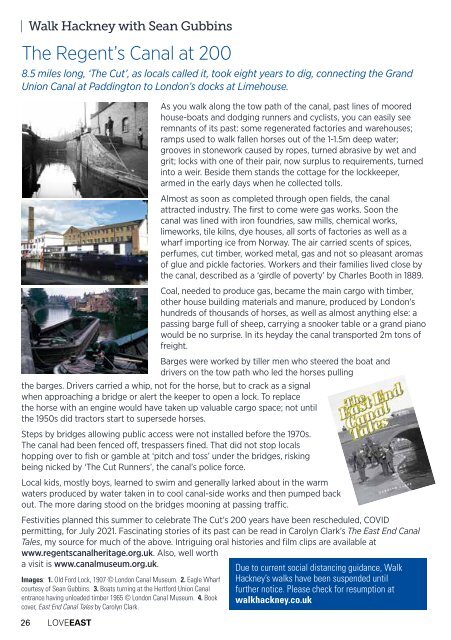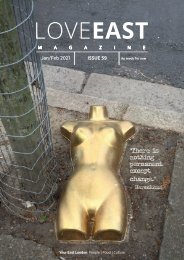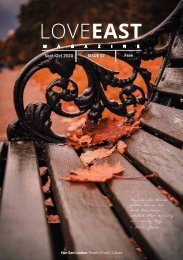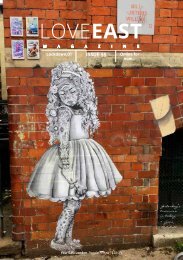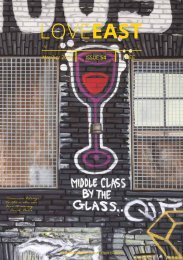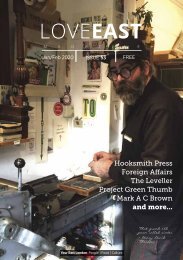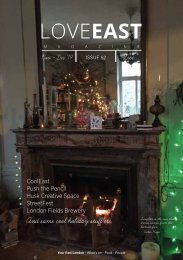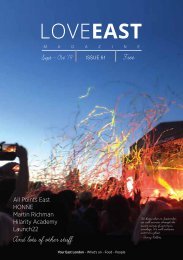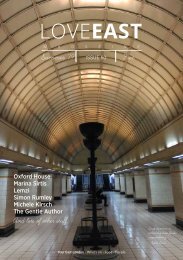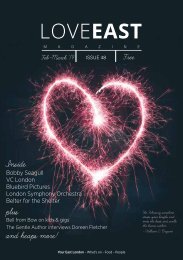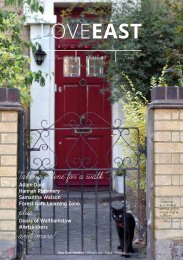LoveEast.58
East London Lifestyle magazine with features on local people, business, the arts, culture and more.
East London Lifestyle magazine with features on local people, business, the arts, culture and more.
Create successful ePaper yourself
Turn your PDF publications into a flip-book with our unique Google optimized e-Paper software.
| Walk Hackney with Sean Gubbins<br />
The Regent’s Canal at 200<br />
8.5 miles long, ‘The Cut’, as locals called it, took eight years to dig, connecting the Grand<br />
Union Canal at Paddington to London’s docks at Limehouse.<br />
Images: 1. Old Ford Lock, 1907 © London Canal Museum. 2. Eagle Wharf<br />
courtesy of Sean Gubbins. 3. Boats turning at the Hertford Union Canal<br />
entrance having unloaded timber 1965 © London Canal Museum. 4. Book<br />
cover, East End Canal Tales by Carolyn Clark.<br />
26 LOVEEAST<br />
As you walk along the tow path of the canal, past lines of moored<br />
house-boats and dodging runners and cyclists, you can easily see<br />
remnants of its past: some regenerated factories and warehouses;<br />
ramps used to walk fallen horses out of the 1-1.5m deep water;<br />
grooves in stonework caused by ropes, turned abrasive by wet and<br />
grit; locks with one of their pair, now surplus to requirements, turned<br />
into a weir. Beside them stands the cottage for the lockkeeper,<br />
armed in the early days when he collected tolls.<br />
Almost as soon as completed through open fields, the canal<br />
attracted industry. The first to come were gas works. Soon the<br />
canal was lined with iron foundries, saw mills, chemical works,<br />
limeworks, tile kilns, dye houses, all sorts of factories as well as a<br />
wharf importing ice from Norway. The air carried scents of spices,<br />
perfumes, cut timber, worked metal, gas and not so pleasant aromas<br />
of glue and pickle factories. Workers and their families lived close by<br />
the canal, described as a ‘girdle of poverty’ by Charles Booth in 1889.<br />
Coal, needed to produce gas, became the main cargo with timber,<br />
other house building materials and manure, produced by London’s<br />
hundreds of thousands of horses, as well as almost anything else: a<br />
passing barge full of sheep, carrying a snooker table or a grand piano<br />
would be no surprise. In its heyday the canal transported 2m tons of<br />
freight.<br />
Barges were worked by tiller men who steered the boat and<br />
drivers on the tow path who led the horses pulling<br />
the barges. Drivers carried a whip, not for the horse, but to crack as a signal<br />
when approaching a bridge or alert the keeper to open a lock. To replace<br />
the horse with an engine would have taken up valuable cargo space; not until<br />
the 1950s did tractors start to supersede horses.<br />
Steps by bridges allowing public access were not installed before the 1970s.<br />
The canal had been fenced off, trespassers fined. That did not stop locals<br />
hopping over to fish or gamble at ‘pitch and toss’ under the bridges, risking<br />
being nicked by ‘The Cut Runners’, the canal’s police force.<br />
Local kids, mostly boys, learned to swim and generally larked about in the warm<br />
waters produced by water taken in to cool canal-side works and then pumped back<br />
out. The more daring stood on the bridges mooning at passing traffic.<br />
Festivities planned this summer to celebrate The Cut’s 200 years have been rescheduled, COVID<br />
permitting, for July 2021. Fascinating stories of its past can be read in Carolyn Clark’s The East End Canal<br />
Tales, my source for much of the above. Intriguing oral histories and film clips are available at<br />
www.regentscanalheritage.org.uk. Also, well worth<br />
a visit is www.canalmuseum.org.uk.<br />
Due to current social distancing guidance, Walk<br />
Hackney’s walks have been suspended until<br />
further notice. Please check for resumption at<br />
walkhackney.co.uk


